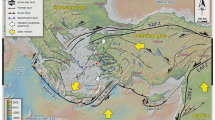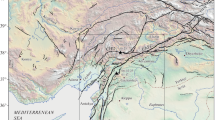Abstract
The North Anatolian Fault (NAF) extends for about 1500 km from Karliova to the east, to the Egean Sea in the west. The Marmara region, located near the western end of the NAF, is a tectonically active zone characterized by the transition between a strike slip stress regime and an extensional one in the Aegean Sea. Microseismic studies performed around the Marmara Sea in 1995 [Tectonophysics 316, 2000, 1], and just before the 1999 Izmit Earthquake Bull. Seism. Soc. Am. 92, 2002a, 361;J. Seismol. 6, 2002b, 287) permitted the analysis of the evolution of seismicity connected to this destructive earthquake and its sequels. Several observations indicate that the aftershock distribution fits well the EW orientation of the NAF, but the ruptures are not simple and linear as a first glance would suggest. Instead they are segmented in at least five pieces as shown by the slip variation and aftershock clusters, showing complexity at different scales (Bull. Seism. Soc. Am. 92, 2002a, 361). There is still a gap, across the northern border of the Marmara Sea that has not ruptured, and this is the only sector that did not break on the NAF since the 1939 great Erzincan earthquake. Will it rupture as a whole with a large magnitude earthquake, or by segments with smaller magnitude events? The Hurst analysis of the overall behaviour of the seismicity in the Marmara region since historical times shows that if a large earthquake occurs in the near future, it might break the complete gap. The Hurst character of the time variation of seismicity is persistent with H= 0.82. The aftershocks of the 1999 Izmit earthquake can be analyzed by using the Hurst method, showing an exceptionally high persistent memory.
Similar content being viewed by others
References
Ambraseys, N., 2002, The seismic activity of the Marmara Sea region during the last 2000 years, Bull. Seism. Soc. Am. 92, 1–18. 437
Bak, P., 1996, HowNatureWorks, SpringerVerlag, NewYork, 212 pp.
Feder, J., 1988, Fractals, Plenum Press, NewYork and London, 283 pp.
Feller, W., 1951. The asymptotic distribution of the range of sums of independent random variables. Ann. Math. Stat. 22, 427–432.
Frøyland, J., 1992, Introduction to Chaos and Coherence, Institute of Physics Publishing, New York, 156 pp.
Goltz, C., 1997, Fractal and Chaotic properties of the earthquakes, Ed. Elsevier, Springer-Verlag, Berlin, 178 pp.
Gurbuz, C., Aktar, M., Eyidogan, H., Cisternas, A., Haessler, H., Barka, A., Ergin, M., Turkelli, N., Polat, O., Uçer, S.B., Kuleli, S., Baris, S., Kaypak, B., Bekler, T., Zor, E., Biçmen, F. and Yörük, A., 2000, The seismotectonics of the Marmara Sea region (Turkey): Results from a microseismic experiment, Tectonophysics 316, 1–17.
Hurst, H.E., 1951, Long-term storage capacity of reservoirs, Am. Soc. Civil Eng. Trans. 2447, 770–808.
Lomnitz, C., 1994, Fundamentals of Earthquake Prediction, John Wiley & Sons, 344 pp.
Ogata, Y. and Abe, K., 1988, Statistical models for earthquake occurrences and residual analysis for point processes, J. Am. Stat. Assoc. 83(401), 9–27.
Parsons, T., 2000, Heightened odds of large earthquakes near Istanbul: An interaction-based probability calculation, Science 288, 661–665.
Polat, O., Haessler, H., Cisternas, A., Philip, H., Eyidogan, H., Aktar, M., Frogneux, M., Comte, D. and Gürbüz, C., 2002a, The Izmit (Kocaeli), Turkey earthquake of 17 August 1999: Previous seismicity, aftershocks, and seismotectonics, Bull. Seism. Soc. Am. 92(1), 361–375.
Polat, O., Eyidogan, H., Haessler, H., Cisternas, A. and Philip, H., 2002b, Analysis and interpretation of the aftershock sequence of the August 17, 1999, Izmit (Turkey) earthquake, J. Seismol. 6, 287–306.
Stein, R.S., Barka, A.A. and Dieterich, J.H., 1997, Progressive failure on the North Anatolian fault since 1939 by earthquake stress triggering, Geophys. J. Int. 128(3), 594–604.
Author information
Authors and Affiliations
Rights and permissions
About this article
Cite this article
Cisternas, A., Polat, O. & Rivera, L. The Marmara Sea region: Seismic behaviour in time and the likelihood of another large earthquake near Istanbul (Turkey). Journal of Seismology 8, 427–437 (2004). https://doi.org/10.1023/B:JOSE.0000038451.04626.18
Issue Date:
DOI: https://doi.org/10.1023/B:JOSE.0000038451.04626.18




